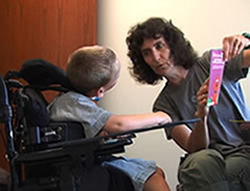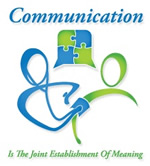|
We are highlighting...
|
The AAC-RERC, Augmentative Communication Inc. and the Central Coast Children's Foundation just launched a new website to provide information for healthcare providers, family members, patients, researchers, educators and policy makers about existing research, policy and practical strategies that address communication barriers across the healthcare continuum.
Improving communication in medical settings enhances patient safety and outcomes, reduces medical costs and increases patient satisfaction. |
|
Susan Fager, David Beukelman, and Tom Jakobs presented on "innovative solutions for supporting the communication of individuals with minimal movement" at the Rehabilitation Engineering Society of North America (RESNA) Conference in New Orleans.
|

|
This new website provides guidelines for teaching literacy skills to learners with special needs, especially learners with complex communication needs. The site provides information on what skills to each, how to teach literacy skills to individuals with complex communication needs, and videotaped examples of instruction with learners with special needs |

|
Pamela Kennedy (AAC-RERC Writers Brigade) describes 7 steps for emergency preparation that are critical for all individuals with complex communication needs.
This webcast is part of the AAC-RERC webcast series. In 2008, over 9,000 individuals viewed an AAC-RERC webcast. |
Recent Presentations and Publications
McCathy, J., Fager, S., Beukelman, D. (2008). Dynamic capture and representation of visual content in medical settings. American Speech-Language-Hearing Association Leader, 13, 84
Higginbotham, D.J. (February, 2009). When navigating the interaction timestream is your AAC device a kayak, an inner tube or a cement block (tied to your ankle)? Presentation at the Division 12 Augmentative and Alternative Communication Conference, American Speech Language and Hearing Association, Rockville, MD.
Fager, S., Beukelman, D., & Jakobs, T. (June, 2009). Supporting Communication of Individuals with Minimal Movement. Presentation at the Annual Conference of the Rehabilitation Engineers Society of North America, New Orleans, LA.
|
Upcoming Presentations
AAC for Adults with Neurodegenerative Disease
Christopher Gibbons, Ph.D., CCC/Sp
October 9, 2009
Oregon Speech and Hearing Assn
Contact information:
AAC Clinical Pathways for Neurodegenerative Disease
Christopher Gibbons, Ph.D., CCC/Sp
Oregon Health & Science University/CDRC
October 10th, 2009
Contact Information:
|
The Rehabilitation Engineering Research Consortium on Communication Enhancement (AAC-RERC) is funded under grant #H133E080011 from the National Institute on Disability and Rehabilitation Research (NIDRR) in the U.S. Department of Education's Office of Special Education and Rehabilitative Services (OSERS).
|





